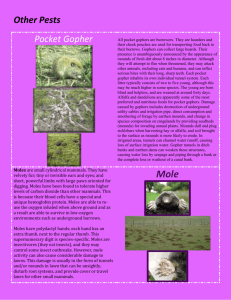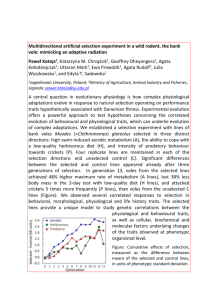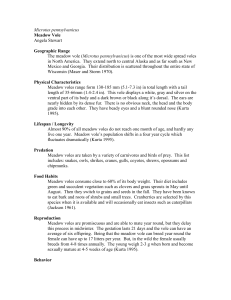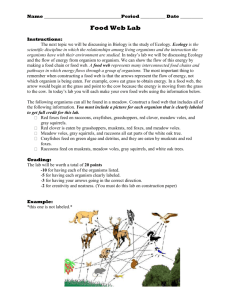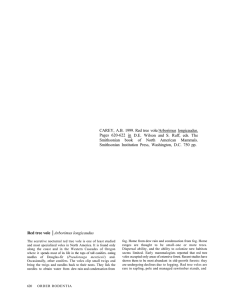THE EFFECTS OF MATRIX STRUCTURE ON MOVEMENT DECISIONS OF MEADOW VOLES R
advertisement
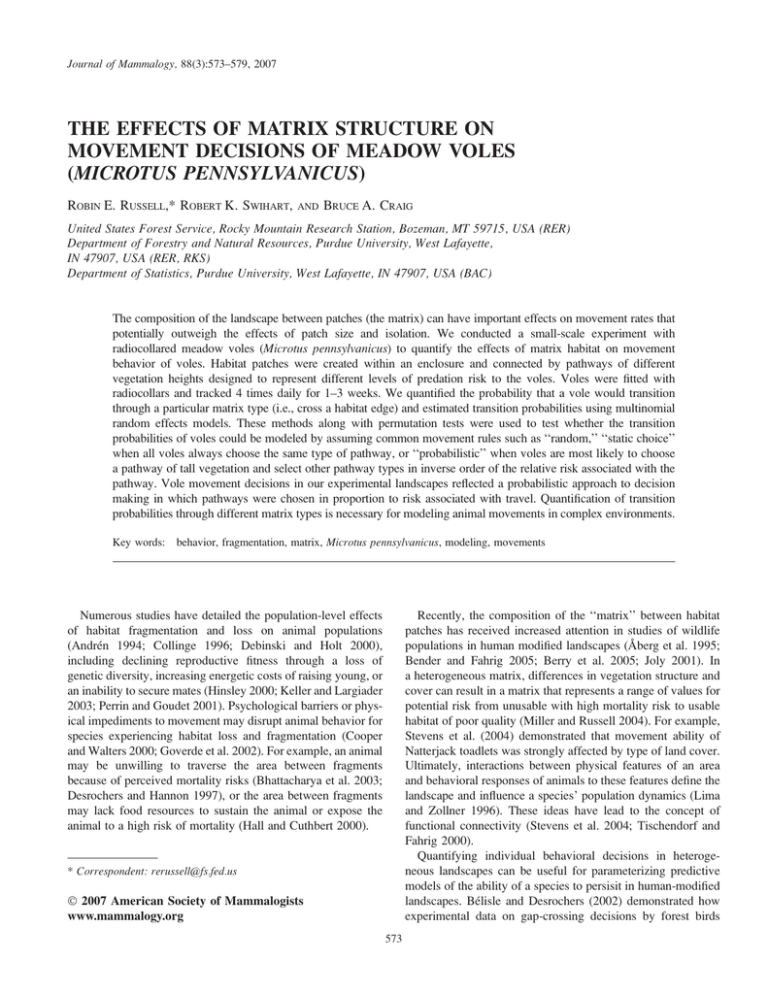
Journal of Mammalogy, 88(3):573–579, 2007 THE EFFECTS OF MATRIX STRUCTURE ON MOVEMENT DECISIONS OF MEADOW VOLES (MICROTUS PENNSYLVANICUS) ROBIN E. RUSSELL,* ROBERT K. SWIHART, AND BRUCE A. CRAIG United States Forest Service, Rocky Mountain Research Station, Bozeman, MT 59715, USA (RER) Department of Forestry and Natural Resources, Purdue University, West Lafayette, IN 47907, USA (RER, RKS) Department of Statistics, Purdue University, West Lafayette, IN 47907, USA (BAC) The composition of the landscape between patches (the matrix) can have important effects on movement rates that potentially outweigh the effects of patch size and isolation. We conducted a small-scale experiment with radiocollared meadow voles (Microtus pennsylvanicus) to quantify the effects of matrix habitat on movement behavior of voles. Habitat patches were created within an enclosure and connected by pathways of different vegetation heights designed to represent different levels of predation risk to the voles. Voles were fitted with radiocollars and tracked 4 times daily for 1–3 weeks. We quantified the probability that a vole would transition through a particular matrix type (i.e., cross a habitat edge) and estimated transition probabilities using multinomial random effects models. These methods along with permutation tests were used to test whether the transition probabilities of voles could be modeled by assuming common movement rules such as ‘‘random,’’ ‘‘static choice’’ when all voles always choose the same type of pathway, or ‘‘probabilistic’’ when voles are most likely to choose a pathway of tall vegetation and select other pathway types in inverse order of the relative risk associated with the pathway. Vole movement decisions in our experimental landscapes reflected a probabilistic approach to decision making in which pathways were chosen in proportion to risk associated with travel. Quantification of transition probabilities through different matrix types is necessary for modeling animal movements in complex environments. Key words: behavior, fragmentation, matrix, Microtus pennsylvanicus, modeling, movements Recently, the composition of the ‘‘matrix’’ between habitat patches has received increased attention in studies of wildlife populations in human modified landscapes (Åberg et al. 1995; Bender and Fahrig 2005; Berry et al. 2005; Joly 2001). In a heterogeneous matrix, differences in vegetation structure and cover can result in a matrix that represents a range of values for potential risk from unusable with high mortality risk to usable habitat of poor quality (Miller and Russell 2004). For example, Stevens et al. (2004) demonstrated that movement ability of Natterjack toadlets was strongly affected by type of land cover. Ultimately, interactions between physical features of an area and behavioral responses of animals to these features define the landscape and influence a species’ population dynamics (Lima and Zollner 1996). These ideas have lead to the concept of functional connectivity (Stevens et al. 2004; Tischendorf and Fahrig 2000). Quantifying individual behavioral decisions in heterogeneous landscapes can be useful for parameterizing predictive models of the ability of a species to persisit in human-modified landscapes. Bélisle and Desrochers (2002) demonstrated how experimental data on gap-crossing decisions by forest birds Numerous studies have detailed the population-level effects of habitat fragmentation and loss on animal populations (Andrén 1994; Collinge 1996; Debinski and Holt 2000), including declining reproductive fitness through a loss of genetic diversity, increasing energetic costs of raising young, or an inability to secure mates (Hinsley 2000; Keller and Largiader 2003; Perrin and Goudet 2001). Psychological barriers or physical impediments to movement may disrupt animal behavior for species experiencing habitat loss and fragmentation (Cooper and Walters 2000; Goverde et al. 2002). For example, an animal may be unwilling to traverse the area between fragments because of perceived mortality risks (Bhattacharya et al. 2003; Desrochers and Hannon 1997), or the area between fragments may lack food resources to sustain the animal or expose the animal to a high risk of mortality (Hall and Cuthbert 2000). * Correspondent: rerussell@fs.fed.us Ó 2007 American Society of Mammalogists www.mammalogy.org 573 574 Vol. 88, No. 3 JOURNAL OF MAMMALOGY may be used to create more realistic spatially explicit models of animal movements. Quantifying the effects of the matrix on animal movements is important for producing predictive models of animal movements in real landscapes. Bender and Fahrig (2005) demonstrated that in simulated landscapes with large numbers of different matrix types, the effects of the matrix outweighed the effects of patch size and isolation on interpatch movement rates. One way to quantify the effects of the matrix on movement rates is to measure the tendency of an animal to move across habitat boundaries (Schultz and Crone 2001). Schultz and Crone (2001) found that incorporating the behavior of butterflies at habitat boundaries into models of patch residence times increased the consistency of the model with mark–release–recapture data. Numerous studies have used voles in experimental systems exploring the effects of habitat fragmentation on dispersal, population genetics, movement distances, switching rates between habitats, space use, and demographics (Aars et al. 1999; Aars and Ims 2000; Andreassen et al. 1998; Coffman et al. 2001; Diffendorfer et al. 1995; Lin and Batzli 2004). Previous studies have indicated that vegetation structure can have significant effects on movements of voles, presumably by affecting predation risk. For example, Aars et al. (1999) determined that movement in the bare ground matrix of their experimental landscape resulted in significantly increased levels of predation relative to movements in corridors. Coffman et al. (2001) determined that constructing corridors of habitatlike vegetation between habitat patches increased rates of interpatch movements, reinforcing the influence of vegetation structure and cover on movements of voles. We created a matrix consisting of vegetation of varying heights to represent differential risks of exposure to predation for meadow voles (Microtus pennsylvanicus). Our experiments were designed to quantify the effects of the matrix on movement behavior of meadow voles and test 3 models of animal movements: a null model of random movements, a probabilisitic model where animals choose pathways according to an a priori probability (i.e., Gustafson and Gardner 1996), or a model in which all animals choose the same type of pathway. An example of the last type of movement model is the ArcView function ‘‘Cost Distance’’ where the least-cost pathway to reach a source is calculated for every cell on the landscape (Environmental Systems Research Institute 1999– 2004). Presumably, all animals could then travel along the least-cost pathway. We introduced voles to an experimental landscape to determine the probability that a vole would transition between habitat patches through a particular type of vegetation. The study was designed to measure small-scale movements reflective of foraging behavior (i.e., behavior within a home range). We expected that preferences of voles would be inversely related to the predation risk perceived by the voles, resulting in the following ordering of transition probabilities: tall . medium . short . bare. We labeled this type of preference a ‘‘probabilistic’’ movement rule. We asked whether movements of voles could be described by random choice, probabilistic movements, or by a static choice strategy in which voles almost always choose the path type with the lowest risk (i.e., least cost). We also estimated the process variation associated with repeated measurements on individual voles to see what role individual heterogeneity played in determining movement choices. We trapped voles and placed them in experimental landscapes to estimate the probability of movements by voles through different types of vegetation structure, and to test whether movements corresponded to random, static choice, or probabilistic movement choices. Two experimental landscape designs were used in this study: in one the matrix consisted of narrow strips of vegetation (referred to as the ‘‘corridor’’ experiment) and in the other of continuous swathes of vegetation (referred to as the ‘‘matrix’’ experiment). MATERIALS AND METHODS Study area.— We trapped meadow voles used in the study at the Purdue Wildlife Area, located approximately 16 km west of Purdue University (approximately 40.4239848N, 86.9289358E). We set Sherman traps (H. B. Sherman Traps, Inc., Tallahassee, Florida) in transects of varying length in appropriate habitat—tall vegetation consisting mainly of goldenrod (Solidago) and thistle plants (Cirsium) throughout the wildlife area. We baited traps with sunflower seeds and apple slices, and opened them between sunset and sunrise. We transported trapped voles to the Purdue Wildlife Area Animal Care Facility, anesthetized them with isoflurane, and fitted them with 1.5-g radiocollars (Holohil Systems Ltd., Carp, Ontario, Canada). All methods followed the guidelines approved by the American Society of Mammalogists (Animal Care and Use Committee 1998) and were approved by the Purdue Animal Care and Use Committee (protocol 02-019). We only used voles .30 g, and 51 of 53 were males, thereby minimizing effects due to age and sex. Voles were anesthetized by placing 0.5 ml of isoflurane on a cotton ball fixed to the lid of a bell jar and sealing the vole inside the bell jar until the vole was immobilized. We then weighed and marked each vole with an ear tag. After recovery from anesthesia, which generally took less than 1 min, we placed the voles in individual cages and held them for 24 h before releasing them within the study enclosures. Voles were acclimated for at least 12 h before data collection. Corridor study.—During spring 2002, we constructed two 46 46-m enclosures at the Purdue Wildlife Area (Fig. 1). The sides of the enclosures were composed of hardware cloth (stiff metal mesh) and aluminum flashing. The hardware cloth was approximately 60 cm tall and was buried 30 cm below the ground. We placed aluminum flashing 30 cm tall in front of the cloth to minimize escapes by voles from the enclosure. Inside the fence line, sixteen 8 8-m habitat patches (1,024 m2 of habitat) were arranged in a 4 4 matrix and surrounded by a 0.5-m strip of bare ground. One to three 4 1-m-long corridors connected adjacent patches, and vegetation within the corridors was either tall (;0.75 m), medium (;0.35 m), short (;0.05 m), or absent (i.e., bare ground). We assigned corridor types to ensure that no patch was connected to other patches by June 2007 RUSSELL ET AL.—VOLE MOVEMENTS IN COMPLEX ENVIRONMENTS 575 FIG. 1.—Experimental design for corridor experiments in 2002 to assess the vole transition probabilities. Black squares represent habitat patches and narrow rectangles represent corridors. FIG. 2.—Experimental design for matrix experiments in 2003. Black squares represent habitat patches. Lighter squares represent a matrix of nonhabitat of different qualities. 2 of the same corridor type and that the landscape contained 6 of each type of corridor. We maintained heights of the intermediate treatments by using a weed trimmer, and herfj;bicide was used to prevent vegetation growing in the bareground areas. The enclosure had been seeded with Kentucky bluegrass (Poa pratensis L.); however, giant foxtail (Setaria faberi R. Herrm) invaded the area and became the dominant species. In 2002, voles were added to the enclosure as they were captured. A total of 28 voles (2 females and 26 males) were included in the corridor experiment. Vole densities within enclosures ranged from 10 voles/ha to 98 voles/ha (1–10 voles per enclosure). Telemetry locations were taken at least 4 times daily for up to 2 weeks on each vole. On each occasion, we recorded the patch occupied by each vole, whether the vole had moved, and the corridor type connecting the previously occupied patch to the new patch. The number of locations obtained for each vole varied according to how long the collar remained on the vole, and whether the vole escaped from the enclosure. Trials were conducted from mid-August through mid-October 2002. Densities of voles in the wild range widely depending on the habitat. Estimates for voles in pure bluegrass were 14 voles/ha during a study in Illinois (Getz et al. 2005). At an experimental study area in Ohio, Collins and Barrett (1997) created 8 enclosures containing 160 m2 of habitat and colonized them with 6 pairs of meadow voles. Numbers of voles in these enclosures reached an average of 15 per enclosure during the months of August and September, corresponding to a density of 937 voles/ha. At the same study area, La Polla and Barrett (1993) observed roughly 6 voles per 400-m2 patch (150 voles/ha) in August and September. In Duchess County, New York, Ostfeld and Canham (1993) observed densities of 380 voles/ha in 40 40-m plots. Therefore, the densities of voles within our study enclosures were comparable to or lower than those in other studies on meadow voles. Yunger (2004) recorded average distances between recaptures of meadow voles of 14 m in 0.6-ha enclosures with predator access and of 16 m before enclosures were con- structed. The minimum amount of time between recaptures in Yunger (2004) was 24 h. Thus, we believe that the 4-h time periods (630 min) we used were sufficient to capture the majority of the movements made by the voles (16 m is equivalent to moving from one patch to another in our landscape). Matrix study.— During the late summer (August–September) of 2003, the study design was revised to reduce the number of moves to a nonneighboring patch, and to more closely mimic complex landscapes by creating a matrix experiment rather than a corridor experiment. To achieve the former we erected square barriers of aluminum flashing between diagonal pairs of patches (black squares in Fig. 2). To achieve the latter we created a matrix of heterogeneous vegetation types between habitat patches representing different types of landscape cover. The matrix types were 4 8 m and filled the space between habitat patches completely (Fig. 2), in contrast to the narrow corridors used in 2002. The revised study design included only 2 matrix types (short ¼ 0.05 m and tall ¼ 0.30 m) and 1 enclosure. This ensured that if a vole moved to a patch that was situated diagonally across from its previous location, the vole crossed through the same habitat types regardless of whether the move was clockwise or counterclockwise (Fig. 2). Additionally, patch size was decreased to roughly 7.5 7.5 m to accommodate a wider bare ground barrier between the habitat and the fence line. Twenty-five male meadow voles were included in the matrix experiment. Three 2-week experimental sessions were conducted with 10 voles per enclosure during each session. All voles were added at the same time and acclimated for 12 h before data collection. Voles were located approximately every 6 h (0600–0800 h, 1200–1400 h, 1800–2000 h, and 0000 h). Statistical analysis.— Three competing hypotheses were tested regarding movements of voles: random, static choice, and probabilistic. If voles were moving randomly, we expected that each pathway type would be chosen with equal likelihood. If voles were moving according to static-choice rules, we expected that a majority of the time all voles would choose the same type of pathway. If voles were following probabilistic rules, we expected that they would be most likely to choose pathways with 576 Vol. 88, No. 3 JOURNAL OF MAMMALOGY FIG. 3.—Average population transition probabilities for the 2002 corridor experiment. Estimates are made for moves from 4-choice patches only (from interior patches only). Estimates represent the probability of transitioning through a particular corridor type during a 4-h period. Data include 160 traceable moves from 28 voles. Data from bare and short moves and tall and medium moves were combined. Error bars indicate 95% confidence limits. Data points with the same letter have overlapping confidence intervals. taller vegetation, but still use other types of pathways in inverse order to the predation risk perceived by the voles. The random hypothesis was tested using a permutation test (Fisher 1935). We conducted this test by generating reference distributions of movement choices consistent with the null hypothesis of random moves (i.e., all moves were equally probable). Each vole move was assigned a random value corresponding to a possible pathway type including bare ground (i.e., short, tall, etc.) and the distribution of the moves was compared to the observed with a chi-square goodness of fit test. This process was repeated 1,000 times, and the number of times the null hypothesis was rejected (i.e., the number of times the observed frequencies differed from the ‘‘random’’ frequencies) was quantified. Theoretically, under the static-choice hypothesis, we would expect all movements to occur in 1 type of corridor or matrix. However, we realize that this outcome is biologically unrealistic. Therefore, we tested the hypothesis that the majority of moves occurred through 1 pathway type versus ‘‘other’’ pathway types. Tall vegetation was presumed to be the leastcost pathway corresponding to the lowest perceived risk of predation; therefore, we only tested tall vegetation versus ‘‘other’’ pathways. We used a 1-sample test for a proportion in SAS Analyst (SAS Institute Inc. 2002–2003a), and tested whether the proportion of moves through ‘‘other’’ vegetation was less than or equal to 5% versus the alternative that the proportion was greater than 5%. Additionally, we estimated transition probabilities using a multinomial random effects model (Hartzel et al. 2001; SAS Institute Inc. 2002–2003b). Each move was considered a response variable, and individual voles were treated as ‘‘random’’ effects. We used these estimates to determine if vole movement choices reflected ‘‘probabilistic’’ rules, by determining whether all movement choice were selected with a probability greater than 0, and the magnitude of the probabilities reflected our hypothesized preference of tall . medium . short . bare. We determined this by calculating confidence limits on the probability that a vole would transition through a particular pathway type in a 4-h period. Assessing transition probabilities for 4-choice moves only.— Proc NLMIXED in SAS was used to model the multinomial distribution according to Hartzel et al. (2001). The method was chosen because it allowed us to properly fit each logit equation for a category simultaneously and allowed us to adjust the equations for the fact that individual voles are a random sample of a larger population of voles. Including ‘‘vole’’ as a random effect accounted for the potential effects of unmeasured physical and behavioral characteristics associated with each vole. Additionally, it is likely that the repeated observations made on each vole are correlated with one another, and the random effect parameter estimates the deviation from the overall mean attributable to the ‘‘effect’’ of an observation being obtained from an individual vole (cf. Pinheiro and Bates 2000). The results of these analyses allowed us to estimate the probability a vole would transition between patches through a particular corridor or matrix type in a 4-h period. A bootstrapping approach also was conducted, in which individual movements by voles were sampled with replacement and population-level transition probabilities were estimated by averaging movement probabilities across voles. Bootstrapping results were similar to the multinomial, random effects approach and are not presented. RESULTS Corridor experiment (4-choice moves only).— During 2002, 28 meadow voles were monitored and 783 telemetry locations were recorded (average per vole ¼ 27). The number of traceable movements recorded was 160, and 23 moves (2.9% of all telemetry locations) were untraceable. Height of vegetation in patches was approximately 0.75 m. Voles did not select pathways randomly; permutation tests indicated that the observed distribution of moves differed from random in 973 of 1,000 iterations (P ¼ 0.027). Similarly, voles did not use the least-cost path (tall vegetation) to the exclusion of other pathways; a 1-sample test for proportions indicated that voles selected these ‘‘other’’ pathways significantly more than 5% of the time (P , 0.0001). Indeed, approximately 60% of all moves took place through pathways other than tall vegetation. To permit comparison with multinomial results (below), we pooled tall and medium categories and tested whether the number of moves through bare ground and short vegetation combined was equal to or less than 5% of the total. Thirty-seven percent of all moves took place through bare ground or short vegetation, resulting in rejection of the staticchoice hypothesis under this scenario as well (P , 0.0001). We pooled bare and short categories and tall and medium categories for analysis in PROC NLMIXED because of the relatively small number of moves (SAS Institute Inc. 2002– 2003b; Fig. 3). Ninety-five percent confidence limits for June 2007 RUSSELL ET AL.—VOLE MOVEMENTS IN COMPLEX ENVIRONMENTS estimates of transition probabilities for corridors with tall and medium vegetation overlapped with those for short and bare ground corridors. Zero was not included in the confidence limits of any estimates. The estimate of variation attributable to individual voles (the random effect) was 2.44 6 1.46 SE (P ¼ 0.11). Thus, there was no evidence that there were differences in individual vole behavior that contributed significantly to the estimates of population-level movement choices in the corridor experiment. Matrix experiment (4-choice moves only).— During 2003, 933 telemetry locations were recorded on 25 male meadow voles (average per vole ¼ 38). We conducted 3 replicate telemetry sessions with 10 voles each. However, weasel (Mustela) predation during the 1st session prevented data collection on 5 voles. We recorded 357 traceable moves. Voles were never located in the matrix between patches. Voles did not select matrix types randomly when moving between patches; permutation tests followed by assessments of goodness of fit resulted in rejection of the null hypothesis of random movement 947 of 1,000 times (P ¼ 0.053). Similarly, voles did not exclusively use of the tall vegetation matrix; 23% of moves took place through short vegetation, a level of use sufficient to reject the static-choice hypothesis (P , 0.0001). Proc NLMIXED was used to estimate the probability that a vole would transition between patches through a particular matrix type in a 4-h period (Fig. 4). For 4-choice moves, 95% confidence limits on the estimate of the transition probabilities through the matrix of short vegetation did not include 0. Additionally, confidence limits for transitioning through tall versus short vegetation did not overlap (Fig. 4). The estimate of the random effect for this experiment was 1.33 6 0.65 SE (P ¼ 0.049), indicating that for moves through the matrix individual vole behavior was a significant factor in the matrix experiment. DISCUSSION Our experiments indicate that voles neither chose randomly between all available travel routes (the probability of selecting each of the types of pathway was not equal) nor did they invariably select 1 particular type of pathway. Instead pathways were chosen with unequal probabilities that were greater than 0. These 3 potential frameworks (random, probabilistic, and static) represent a continuum ranging from no selection (probabilities are equal), to an intermediate level of selection in which probabilities differ and are greater than 0 for all types of pathway, to an absolute preference in which probabilities are 1 for a single type of pathway and 0 for all others. Behavioral decisions regarding which pathway to take are not the only ways in which different species may respond to landscape heterogeneity. Animals are capable of adjusting their behavior in a variety of other ways when confronted with a heterogeneous landscape. For example, degus (Octodon degus) adjust travel speed, vigilance, and pausing frequencies when moving through habitats of different types (Vasquez et al. 2002). Our observations indicate that voles will travel across bare ground or through short vegetation, which suggests that voles may adjust their behavior to compensate for increased 577 FIG. 4.—Average population transition probability for the 2003 matrix experiment. Estimates are made for moves from 4-choice patches only (from interior patches only). Estimates represent the probability of transitioning through a particular matrix type during a 4-h period. Data include 302 telemetry locations from 25 voles. Error bars indicate 95% confidence limits. Data points with the same letter have overlapping confidence intervals. predation risk. We conclude that behavior of voles in our experimental landscapes conforms to a ‘‘probabilistic’’ rule in which the probability of traveling along a particular route is proportional to the risk associated with that route. This rule would lead to the results observed, in which the least risky routes were not chosen exclusively but were chosen more often than other routes. Previous studies have indicated that vegetation height has significant effects on movements of voles by increasing rates of movement and potentially decreasing predation risk (Aars et al. 1999; Coffman et al. 2001). Thus, movement through tall vegetation may represent ‘‘least-cost’’ movements. Our results indicated that in both experiments, voles choose to travel through tall vegetation more often than other vegetation; however, this choice was not exclusive. Other factors, such as the presence of conspecifics or the ease with which the animals can move through the vegetation, may have affected the perception of risk by a vole. Therefore, it is possible that other types of pathway were actually ‘‘least-cost’’ for voles moving through the landscape. Regardless, designating one pathway for all movements in a particular landscape may lead to inaccurate predictions regarding animal movements. We also noted that the probability of staying in a patch was much higher in the corridor experiment (0.73, 95% confidence limits [95% CL] ¼ 0.65–0.90) than the matrix experiment (0.40, 95% CL ¼ 0.32–0.65). These results indicate that factors other than vegetation height, namely, the extent and composition of vegetation between patches, also influence movement choices by voles. It is possible that the intervening ‘‘matrix’’ was viewed as habitat by voles; although voles were never located in the matrix, short trips into the matrix may have occurred between telemetry readings. Estimates of variation in movement choices attributable to individual voles (the estimate of the random effect) indicate that in at least some settings (for example in our matrix experiment), individual voles may be making choices that differ from 578 JOURNAL OF MAMMALOGY the choices made by the overall population. Incorporating individual heterogeneity in movement choices may increase model realism. For example, Morales and Ellner (2002) concluded that a model incorporating behavioral heterogeneity between individuals and within individuals over time was able to account for observed patterns of spread in Tribolium confusum beetles in experimental landscapes. Russell et al. (2003) demonstrated with simulation studies the effects of nonrandom behavior on the population dynamics of animals. In high-risk landscapes, probabilistic movements resulted in longer persistence times than random movements and in more occupied patches than least-cost movements. Results of both of the simulations and the current field study represent small-scale movements in relatively familiar environments where the animals have at least some knowledge of potential risks. This type of behavior is more reflective of foraging or mate searching in a known area such as a home range. Movements within a home range may not accurately portray largescale dispersal movements or movements through unfamiliar environments. However, the willingness of voles and other animals to cross habitat boundaries and enter into different matrix types likely is reflective of the animal’s decisions when moving through unfamiliar environments. Future research should investigate the effectiveness of ‘‘scaling up’’ from small- to largescale movements (Beever et al. 2006; Morales and Ellner 2002), while integrating behavioral decisions that pertain to the functional connectivity of a landscape. ACKNOWLEDGMENTS We thank P. Waser, N. Slade, Z. Feng, and 2 anonymous reviewers for helpful comments on the manuscript. Funding for the project was provided by the American Society of Mammalogists and the John S. Wright Endowment. S. Hecht, A. Reynolds, and S. Lawyer assisted with fieldwork. LITERATURE CITED AARS, J., AND R. A. IMS. 2000. Population dynamic and genetic consequences of spatial density-dependent dispersal in patchy populations. American Naturalist 155:252–265. AARS, J., E. JOHANNESEN, AND R. A. IMS. 1999. Demographic consequences of movements in subdivided root vole populations. Oikos 85:204–216. ÅBERG, J., G. JANSSON, J. E. SWENSON, AND P. ANGELSTROM. 1995. The effect of matrix on the occurrence of hazel grouse (Bonasa bonasia) in isolated habitat fragments. Oecologia 103:265–269. ANDREASSEN, H. P., K. HERTZBERG, AND R. A. IMS. 1998. Space-use responses to habitat fragmentation and connectivity in the root vole Microtus oeconomus. Ecology 79:1223–1235. ANDRÉN, A. 1994. Effects of habitat fragmentation on birds and mammals in landscapes with different proportions of suitable habitat: a review. Oikos 71:355–366. ANIMAL CARE AND USE COMMITTEE. 1998. Guidelines for the capture, handling, and care of mammals as approved by the American Society of Mammalogists. Journal of Mammalogy 79:1416–1431. BEEVER, E. A., R. K. SWIHART, AND B. T. BESTELMEYER. 2006. Linking the concept of scale to studies of biodiversity: evolving approaches and tools. Diversity and Distributions 12:229–335. Vol. 88, No. 3 BÉLISLE, M., AND A. DESROCHERS. 2002. Gap-crossing decisions by forest birds: an empirical basis for parameterizing spatially-explicit, individual-based models. Landscape Ecology 17:219–231. BENDER, D. J., AND L. FAHRIG. 2005. Matrix structure obscures the relationship between interpatch movement and patch size and isolation. Ecology 86:1023–1033. BERRY, O., M. D. TOCHER, D. M. GLEESON, AND S. D. SARRE. 2005. Effect of vegetation matrix on animal dispersal: genetic evidence from a study of endangered skinks. Conservation Biology 19: 855–864. BHATTACHARYA, M., R. B. PRIMACK, AND J. GERWEIN. 2003. Are roads and railroads barriers to bumblebee movement in a temperate suburban conservation area? Biological Conservation 109:37–45. COFFMAN, C. J., J. D. NICHOLS, AND K. H. POLLOCK. 2001. Population dynamics of Microtus pennsylvanicus in corridor-linked patches. Oikos 93:3–21. COLLINGE, S. K. 1996. Ecological consequences of habitat fragmentation: implications for landscape architecture and planning. Landscape and Urban Planning 36:59–77. COLLINS, R. J., AND G. W. BARRETT. 1997. Effects of habitat fragmentation on meadow vole (Microtus pennsylvanicus) population dynamics in experimental landscape patches. Landscape Ecology 12:63–76. COOPER, C. B., AND J. R. WALTERS. 2000. Experimental evidence of disrupted dispersal causing decline of an Australian passerine in fragmented habitat. Conservation Biology 16:471–478. DEBINKSI, D. M., AND R. D. HOLT. 2000. A survey and overview of habitat fragmentation experiments. Conservation Biology 14: 342–355. DESROCHERS, A., AND S. J. HANNON. 1997. Gap crossing decisions by forest songbirds during the post-fledging period. Conservation Biology 11:1204–1210. DIFFENDORFER, J. E., M. S. GAINES, AND R. D. HOLT. 1995. Habitat fragmentation and movements of three small mammals (Sigmodon, Microtus, and Peromyscus). Ecology 76:827–839. ENVIRONMENTAL SYSTEMS RESEARCH INSTITUTE. 1999–2004. ArcMap (9.0). ESRI, Redlands, California. FISHER, R. A. 1935. The design of experiments. Hafner, New York. GETZ, L. L., M. K. OLI, J. E. HOFMANN, AND B. MCGUIRE. 2005. Habitat specific demography of sympatric vole populations over 25 years. Journal of Mammalogy 86:561–568. GOVERDE, M., K. SCHWEIZER, B. BAUR, AND A. ERHARDT. 2002. Smallscale habitat fragmentation effects on pollinator behaviour: experimental evidence from the bumblebee Bombus veteranus on calcareous grasslands. Biological Conservation 104:293–299. GUSTAFSON, E. J., AND R. H. GARDNER. 1996. The effect of landscape heterogeneity on the probability of patch colonization. Ecology 77:94–107. HALL, C. D., AND F. J. CUTHBERT. 2000. Impact of a controlled wetland drawdown on Blanding’s turtles in Minnesota. Chelonian Conservation and Biology 3:643–649. HARTZEL, J., A. AGRESTI, AND B. CAFFO. 2001. Multinomial logit random-effects models. Statistical Modelling 1:81–102. HINSLEY, S. A. 2000. The costs of multiple patch use by birds. Landscape Ecology 15:765–775. JOLY, P., C. MIAUD, A. LEHMANN, AND O. GROLET. 2001. Habitat matrix effects on pond occupancy in newts. Conservation Biology 15:239–248. KELLER, W., AND C. R. LARGIADER. 2003. Recent habitat fragmentation caused by major roads leads to reduction of gene flow and loss of genetic variability in ground beetles. Proceedings of the Royal Society of London, B. Biological Sciences 270:417–423. June 2007 RUSSELL ET AL.—VOLE MOVEMENTS IN COMPLEX ENVIRONMENTS LA POLLA, V. N., AND G. W. BARRETT. 1993. Effects of corridor width and presence on the population dynamics of the meadow vole (Microtus pennsylvanicus). Landscape Ecology 8:25–37. LIMA, S. L., AND P. A. ZOLLNER. 1996. Towards a behavioral ecology of ecological landscapes. Trends in Ecology and Evolution 11:131–135. LIN, Y. K., AND G. O. BATZLI. 2004. Movement of voles across habitat boundaries: effects of food and cover. Journal of Mammalogy 85:216–224. MILLER, M. S., AND R. E. RUSSELL. 2004. Sharp edges, matrix permeability, and individual behavior: considerations for improving estimates of landscape connectivity. Pp. 103–121 in Conserving biodiversity in agricultural landscapes: model-based planning tools for systems with sharp edges (R. K. Swihart and J. E. Moore, eds.). Purdue University Press, West Lafayette, Indiana. MORALES, J. M., AND S. P. ELLNER. 2002. Scaling up animal movements in heterogeneous landscapes: the importance of behavior. Ecology 83:2240–2247. OSTFELD, R. S., AND C. D. CANHAM. 1993. Effects of meadow vole population density on tree seedling survival in old fields. Ecology 74:1792–1801. PERRIN, N., AND J. GOUDET. 2001. Inbreeding, kinship, and the evolution of natal dispersal. Pp. 123–142 in Dispersal (J. Clobert, E. Danchin, A. A. Dhondt, and J. D. Nichols, eds.). Oxford University Press, New York. PINHEIRO, J. C., AND D. M. BATES. 2000. Mixed-effects models in S and S-plus. Springer-Verlag, New York. 579 RUSSELL, R. E., R. K. SWIHART, AND Z. FENG. 2003. Population consequences of foraging decisions in a patchy matrix. Oikos 103:142–152. SAS INSTITUTE INC. 2002–2003a. SAS (9.1) SAS analyst. SAS Institute Inc., Cary, North Carolina. SAS INSTITUTE INC. 2002–2003b. SAS (9.1) PROC NLMIXED. SAS Institute Inc., Cary, North Carolina. SCHULTZ, C. B., AND E. CRONE. 2001. Edge-mediated dispersal behavior in a prairie butterfly. Ecology 82:1879–1892. STEVENS, V. M., E. POLUS, R. A. WESSELINGH, N. SCHTICKZELLE, AND M. BAGUETTE. 2004. Quantifying functional connectivity: experimental evidence for patch-specific resistance in the Natterjack toad (Bufo calamita). Landscape Ecology 19:829–842. TISCHENDORF, L., AND L. FAHRIG. 2000. On the usage and measurement of landscape connectivity. Oikos 90:7–19. VASQUEZ, R. A., L. A. EBENSPERGER, AND F. BOZINOVIC. 2002. The influence of habitat on travel speed, intermittent locomotion, and vigilance in a diurnal rodent. Behavioral Ecology 13:182– 187. YUNGER, J. A. 2004. Movement and spatial organization of small mammals following vertebrate predator exclusion. Oecologia 139:647–654. Submitted 13 March 2006. Accepted 16 October 2006. Associate Editor was Douglas A. Kelt.

